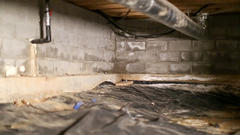7 Steps to Get Moisture Out of Your Crawl Space

Water in the crawl space is a major headache for homeowners. Whether you’re dealing with foundation leaks, burst pipes or other moisture sources, getting rid of that water as soon as possible is essential.
Comprehensive crawl space encapsulation is the perfect solution to a wet crawl space. Here’s an overview of the encapsulation process and how it can protect your home.
1. Identify Damage

Inspect your crawl space thoroughly for any cracks, gaps or holes that allow water through. Signs of vulnerabilities can include wet spots on the walls or floor after heavy rains, or mold growth in certain areas of the crawl space.
Take a good look at plumbing fixtures and HVAC ducts. If these are leaking, you may need professional assistance to seal them off and prevent water intrusion.
Sealing off these obvious entry points is a critical first step towards drying out your crawl space for good.
2. Install A Vapor Barrier

If your crawl space has an exposed dirt floor, it’s easy for moisture or wet air to seep in. A crawl space vapor barrier is the best line of defense for your home from excess moisture.
This thin yet durable membrane repels water and humid air from breaching your crawl space. It’s also tear-resistant, preventing rodents, insects or other pests from setting up shop in the space.
Professional vapor barrier installation from Groundworks is the best way to ensure an airtight seal. Our experts carefully measure and cut the barrier to provide total coverage to your crawl space.
3. Add Insulation

After installing the vapor barrier, you’ll want to insulate the crawl space. Insulation helps regulate the air quality of your crawl space by keeping hot or cool outside air away and limiting the potential for mold growth
Our ExTremeBloc™ rigid foam insulation panels offer advanced protection and peace of mind. Traditional fiberglass insulation can break down or lose effectiveness over time due to a variety of factors, including water exposure.
Old, damaged insulation can affect conditions inside your crawl space and beyond. Heating and cooling your home efficiently becomes more difficult without proper insulation, raising your energy bills.
4. Install a Dehumidifier

Maintaining healthy airflow in your crawl space is essential for preventing humidity that leads to mold and wood rot. Wet air in your crawl space can also create unpleasant odors that waft upwards into the rest of your home. That’s where a dehumidifier comes in.
A crawl space dehumidifier collects excess moisture in the air and cycles it out for removal, keeping the air in your basement dry and healthy. Some dehumidifiers also include filtration systems that can catch mold spores and other unhealthy contaminants and remove them, creating a healthy atmosphere for your whole home.
5. Ensure Proper Drainage

Your home’s gutters and downspouts should allow water to flow away from your home. Poor grading for your exterior drainage systems can allow water to pool near your foundation, putting the crawl space at high risk of leaks. Clean your gutters regularly of leaves, dirt and debris to maintain steady flow, and reposition them as needed if you’re noticing water backflowing towards your home.
6. Install a Sump Pump

Crawl spaces can flood even if you do everything to prevent it. For the ultimate in peace of mind, make sure you have a sump pump installed at the lowest section of the crawl space.
These pumps collect water and cycle it out for efficient removal. You may also want to consider installing a battery-powered backup pump in case of power outages or other weather emergencies.
7. Routine Maintenance

Regular cleaning and crawl space maintenance is the easiest way to prevent water damage or other problems in your crawl space. You’ll be able to catch problems before they spiral out of control, and proactive care will definitely be more cost-effective than extensive repairs.
Get Expert Help From Groundworks

Concerned about a damp or leaky crawl space? Schedule a free crawl space inspection with the crawl space repair experts at Groundworks to learn more about water in your crawl space and the best solutions to address them.
FAQs
While some homeowners may attempt it, proper encapsulation requires professional installation to ensure the vapor barrier is correctly sealed and the insulation is properly installed.
The process typically takes a few days to a week, depending on the size of the crawl space and the extent of work needed.
The cost varies depending on the size of the crawl space and the materials used. Groundworks offers free inspections to provide the most accurate estimate.